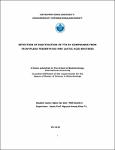| dc.description.abstract | Although tetrodotoxin (TTX) is an extremely neuro-toxic compound, its activities have potential applications as medicines. There must be an efficient antidote for this toxin to minimize risks in clinical trial as well as in poisoning from TTX consumption. Therefore, screening for compounds which can neutralize, detoxify the toxicity of TTX or reduce its negative effects is necessary. Studies proved that exopolysaccharide (EPS) was one of the main compounds which bacteria produce to confer their resistance to harsh conditions or toxic environment. Research also revealed that TTX was removed from puffer fish meat by traditional fermentation of Japanese in which lactic acid bacteria played the main role. Some studies showed that hemolymph from Carcinoscorpius rotundicauda containing TTX binding protein could detoxify TTX in mice. Therefore, this study test for TTX detoxification capacity by using EPS produced by Leuconostoc mesenterium, Lactobacillus plantarum, Enterococcus faecium and hemolymph and hemocyanin of Tachypleus tridentatus. The experiment was conducted on 7-8 weeks old, weight 20±1g male mice. The results indicated that optimal dose of extrapolysaccharide (EPS) (248.449 μg) of Leuconostoc mesenterium and Cu2O (54.204 μg), incubated for 40.04 mins can help detoxify TTX in mice. In another studies, optimal dose of EPS (147.946 μg) Enterococcus faecium combined with Cu2O (55.325 μg) incubated for 40.415 mins that can also help detoxify TTX in mice while EPS from Lactobacillus plantarum showed no TTX detoxification capacity. In order to partially understand the TTX detoxification capacity of EPS, EPS characterization of EPS were done. Leuconostoc mesenteriun, Enterococcus faecium and Lactobacillus plantarum have EPS molecular weight of 3.8x104 Da, 4.4x104 Da, and 4x104 Da, respectively, using gel permeation chromatogrphy. By thin layer chromatography (TLC) and high performance liquid chromatography (HPLC), the EPS of these bacteria contained glucose. However, the EPS of these bacteria is different from some functional group by FT-IR analysis. The results also that hemolymph from Tachypleus tridentatus, Carcinoscorpius rotundicauda can only prolong the survival time of treated mice to 80 – 90 mins and 40 – 45 mins respectively in which hemocyanin, the main component in hemolymph with molecular weight of approximately 66 kDa play insignificant role in TTX detoxification. In summary, EPS from Leuconostoc mesenterium and Enterococcus faecium could contribute to TTX detoxification, leading to mice
iii
survival while EPS from Lactobacillus plantarum showed no TTX detoxification capacity. Hemocyanin of hemolymph from Tachypleus tridentatus and Carcinoscorpius rotundicauda had no TTX detoxification.
Keywords: Leuconostoc mesenterium, Lactobacillus plantarum, Enterococcus faecium, hemocyanin, exopolysaccharide, tetrodotoxin, Tachypleus tridentatus, Carcinoscorpius rotundicauda | en_US |


